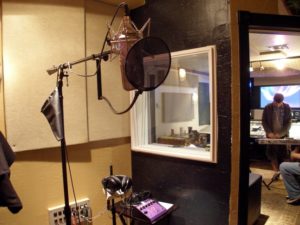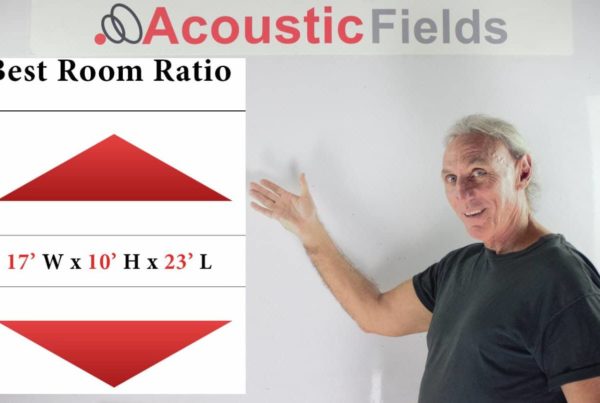What is the best acoustic treatment for windows? This is a question that seems to be asked quite regularly so today we are going to address it and many new improvements in this technology have been created since this blog was posted. Updated on October 25th, 2019
Windows are a problem because we all have them in our rooms. They are an issue for the sound quality inside the room. They are also a noise or barrier issue. They lack the density of the walls they are supported by and noise finds the weakest link in any wall design. Do not be tricked by terms such as acoustic windows. Companies use the word acoustic to attach to everything just to increase the price for the uniformed. I see this a lot in the recording studio window literature.
You can be in a room that has a lot of wood, you could be in a room that has a lot of carpeting, you could be in a room that has a lot of windows. Each has its own distinct sound, even though they’re the same size room and the sound sources are the same in each room, they will all three sound differently. What is the difference between the three rooms? Materials. Materials that the room is made out of. So, that said, windows and glass are the worst sound you could ever imagine to bounce any sound energy of (them). So reflections from window surfaces have to be treated.
What’s the best way to acoustically treat windows?
My solution is to get rid of them. They just have to go> They can’t be in any room that is dealing with sound in a serious matter. You don’t see them in control rooms, other than in the places where they divide the live and control, Today, a lot of studios eliminate the window and go with video monitoring. This avoids the glass completely. No need anymore for recording studio windows.
If we have recording studio windows or acoustic windows, you must decide on what treatment methods you are going to place on them. We do not want to deal with the reflections from these hard surface areas. We must be careful with “glass sound”.
Now what do we cover them with?
We have two things we have to consider. We have the sound energy in the room that must be treated and, if the window is on a surface, hopefully not a sidewall, but if it’s on a surface that needs a certain kind of treatment then we have to put that treatment on the window. Treatment falls into two types: absorption and diffusion.
Foam Window Treatment: https://www.acousticfields.com/product/foam-ladder/
Diffusion Treatment: https://www.acousticfields.com/product-category/sound-diffusion/qd-series/
We must first decide what treatment type we are going to use. This will depend on the size of the room and the usage. Usage or what you are doing in the room is critical. If the window is a rear wall, we probably are going to need some diffusion. If recording studio windows are located on the front or sidewalls, we must be very careful with the absorption or diffusion treatment since it will have an impact on what we hear in our mixes If we have to do a custom design for your recording studio windows we can do that. No need to look at acoustic windows. We can measure and build our own recording studio windows.
Absorption is really the technology people who look towards acoustic treatment for windows most turn to. They just simply want to cover the window so that there are no reflections off the glass and they get no glass sound in their room and that’s a good way to do that. That will work if now our acoustic window is just for treatment. Treatment will be the easier of the differences that recording studio windows must function at. We must also use the window to stop noise.
Drapes are good.
You have to have the right density and thickness of the drape. You really need to have the right thread count because you can’t have things going through the fabric and striking the glass. So you need to do that and get that taken care of and then once you have the reflections from the glass minimized, then you can work forward from there. The issue with drapes is not that they work to absorb it is how well do they absorb. In critical listening environments, we must have the rates and levels of absorption for our chosen room usage.
If you were ever invited to a party with music in a glass conservatory, would you attend?
No. Everybody knows from my videos, that glass sound is my worst sound. With our digital sources today, they overemphasize high frequencies, and when you take that overemphasis in the digital domain and you bounce it off a glass you compound the problem by a factor of a hundred. Sound takes on the tonal characteristics of the surfaces it strikes. Glass produces glass sound which is a harsh brittle sound. Wood produces a smooth middle range tonal balance. You have to be very careful with glass. I hear it immediately in a room and it’s just a situation that has to be treated with absorption or diffusion technology to match position and usage.
In Summary
So I hope that helps you. If you have any questions at any time I am always on hand to help answer them. Leave them in the comments section or email me at info@acousticfields.com. If you would like a free analysis of your room, please complete the form on this page https://www.acousticfields.com/free-room-analysis/ and we will run a free analysis for you. If you would like to learn more about room acoustics please sign up for my free videos and ebook by joining the mailing list here. I send room tuning tips and things for you to test in your room every Wednesday. They are easy to follow and really help you enjoy more of your music.
Thanks and speak soon
Dennis









Hello Mr. Foley,
My name is Edwardo Santiago and I just read a small article of yours on windows in home studios. I’m currently in the process of updating my production system at home that sits in a spare room that is approximately 11′ x 12′. I’ve always had decent results with acoustic paneling that I constructed from various acoustic foams and mineral wool panels I designed into different sizes and thicknesses, but I’m about to start a new design for my room using professionally designed panels from Prime Acoustic.
The room has two windows that run most of the height on the left side of the wall (taking about 1/2 of the space) that i’ll use as my front wall where my L,C,R monitors & picture screen sit (I have a 5.1 setup). The right corner of this wall is where I found my LFE to have the strongest output therefore that’s where I think it will stay. The left corner of this wall is where I found the sub frequency energy to collect into the most so I’m planning on placing a Bag End E-Trap in this corner to help tune the sub frequency response after applying ample passive bass traps in all corners of the room (Prime Acoustic Max Traps).
I’m hoping to build a false wall to cover the windows on this wall plus the part of the wall containing no window, in order to create an even covering across the entire wall on which to place acoustic paneling (Prime Acoustic Broadway Panels), hoping to balance the material space of the room.
Would you suggest I build the false wall from the same sheet rock used in the original wall or another material? Would it be beneficial to insulate the false wall with mineral wool or some other dense material? Does this idea make sense?
I will cover the remaining walls with Prime Acoustic 2″ or 3″ Broadway panels to my left & right (floating 3″ off the wall) as well as three Flexi Fussor diffusion panels on the rear wall, plus three Cloud panels above mix position, a couple hanging panels above the rear of the room as it ascends higher by three or more feet from the top of the area where I’ll build the false wall, and two Cumulus Tri-Corner Bass Traps in the rear ceiling corners.
I hope this isn’t too much to ask of you. I just thought it’d be cool to have your thoughts on my idea.
Thank you,
Edwardo Santiago
Hi Edwardo,
Windows do two things that must be managed. First, you must manage the vibrations caused by the glass going diaphragmatic when low frequency sound pressure strikes it. The window moves and creates sound. It must be managed with the proper dampening material to avoid this movement.
Secondly, the glass surface must be treated with either sound absorption or sound diffusion technology depending on room usage and window position. Glass surfaces actually alter the frequency response of sound energy that strikes it. Covering them is a necessity.
Your room usage, size, and volume indicate to my data base that the products you are using to absorb low frequency energy do not have the required rate and level of absorption to deal with the frequency and magnitude of the room’s size and volume.
Hello Dennis,
Thank you for replying so quickly. Forgive me for taking so long to get back to you. Since I’m just in the planning stage I think I should explain the plan a bit further. The plan is to cover the windows with a false wall similar to a baffle wall that will cover the 2 windows plus the remaing portion of the wall without a window to create a completely symetric acoustic covering over the entire front wall. In the left and right corners of this new front wall I will install 4 Max Traps (2 on each side) that will cover close to the entire height of the corners from floor to ceiling. The right side corner will contain the powered LFE channel where it outputs it’s strongest level and the left side corner will contain the Bag End E-Trap (Electronic Bass Trap) that I’ll use to tune the frequencies according to what may need tuning.
The two floor corners in the rear of the room will have 1 Max Trap each while the two ceiling corners in the rear will have the Cumuls Tri-Corner Bas Traps. The front, left and right walls will have three or four Broadway Panels installed three inches off the wall. Above the mix position will hang a cloud formed by three Broadway Panels and the rear wall behind the mix postition will have three Flexi Fussors to reintroduce depth into the room. I may have to hang a handful of small square Broadway Panels from the rear ceiling as the ceiling ascends from 8′ at the height of the front wall to 12′ at the height of the rear wall.
This is just the planning stage and I’m just hoping to get a better handle on the plan plus figure out the best materials with which to build the false wall. I can try to send a private message to see if some of your products would work better than the Prime Acoustic.
Thank you
Thx for the great advice, Dennis. Got me thinking about whether a framed linear block diffuser backed w 3-4″ insulation, covered and then some kind of rubber bumper around the treatment frame to create airtight seal against window frame would manage glass resonance? Also, can you elaborate on drapery thread count. Initially I pondered whether wood blinds would be aesthetically useful but your point bout any sound interaction w glass is unideal struck home. If you have better idea than drapery/wood blinds/gobo for French doors of 24.5×27.5×8 (approx. not closed rectangle, may bust 1/2 deadwall separating kitchen n living room out to open up further..eek) Livingroom/kitchen space that would be great. I plan to do 3D vertice superchunk absorption end to end and floor to ceiling possibly along floor vertices too. Ceiling height is causing issue, pondering some kinda wood panel grille type acoustic ceiling panels, rulonco esque or the like, but idk tbh bc there may be a simpler yet aesthetic option available? It already has wood floors, cement Slab. Have not ironed out speaker position but I am concerned about keeping sound from escaping windows n doors primarily. Noise within the house not an issue. The other sides are our property/rooms. Generally considering NE room concept for the probable “back” wall featuring windows? I figure I can block/absorb/diffuse more sound at the two small window points whereas the french door.. Can’t win em all. But maybe I should be up against the wall with windows to get rid of first reflection from the back? House was properly rennovated w insulation and energy efficient windows so it’s already pretty quiet and stable. Cinderblock w stucco exterior loadbearing walls/drywall interior/ceiling. Removing doors/windows not an option unfortunately.
Hi Spence,
Glass has a surface that is not reflection friendly when it comes to audio presentation. Glass also moves when sound pressure is exerted. You must damp the vibrations and cover the surface with the proper option or diffusion technology for that room usage. Fabric rates and levels of absorption are not consistent and predictable. You must have proper rates and levels of absorption in audio rooms whether they are for voice or music.
t appears from your comments that you are doing a lot of “variable guessing”. You are confusing barrier technology with treatment. You need to take a macro level view of your room and first and foremost define and measure all the noise and acoustical requirements within the room.
Go to this link and fill out the information in this link. I will then compare it to our data base and lets take a look at frequency / magnitude / RT-60 / noise.
https://www.acousticfields.com/free-room-analysis/
That makes sense to avoid windows. They only leak sound. They’re thin and they can’t be treated acoustic pads like walls or floors.
J, Yes. They have a negative impact on frequency response.
If you have a room 5.4m long x 3.5m wide x 2.7m high (no choice) would you rather:
1.) Would you have speakers on the short side (3.5m would be back/front wall) or long side (5.4m would be the front/back wall)
2.) with 1 window/door unit would you have it rather on the back wall (behind listening position) or front wall behind the speakers.
Modes seem to be the same for the room no matter if 3.5m is length or width